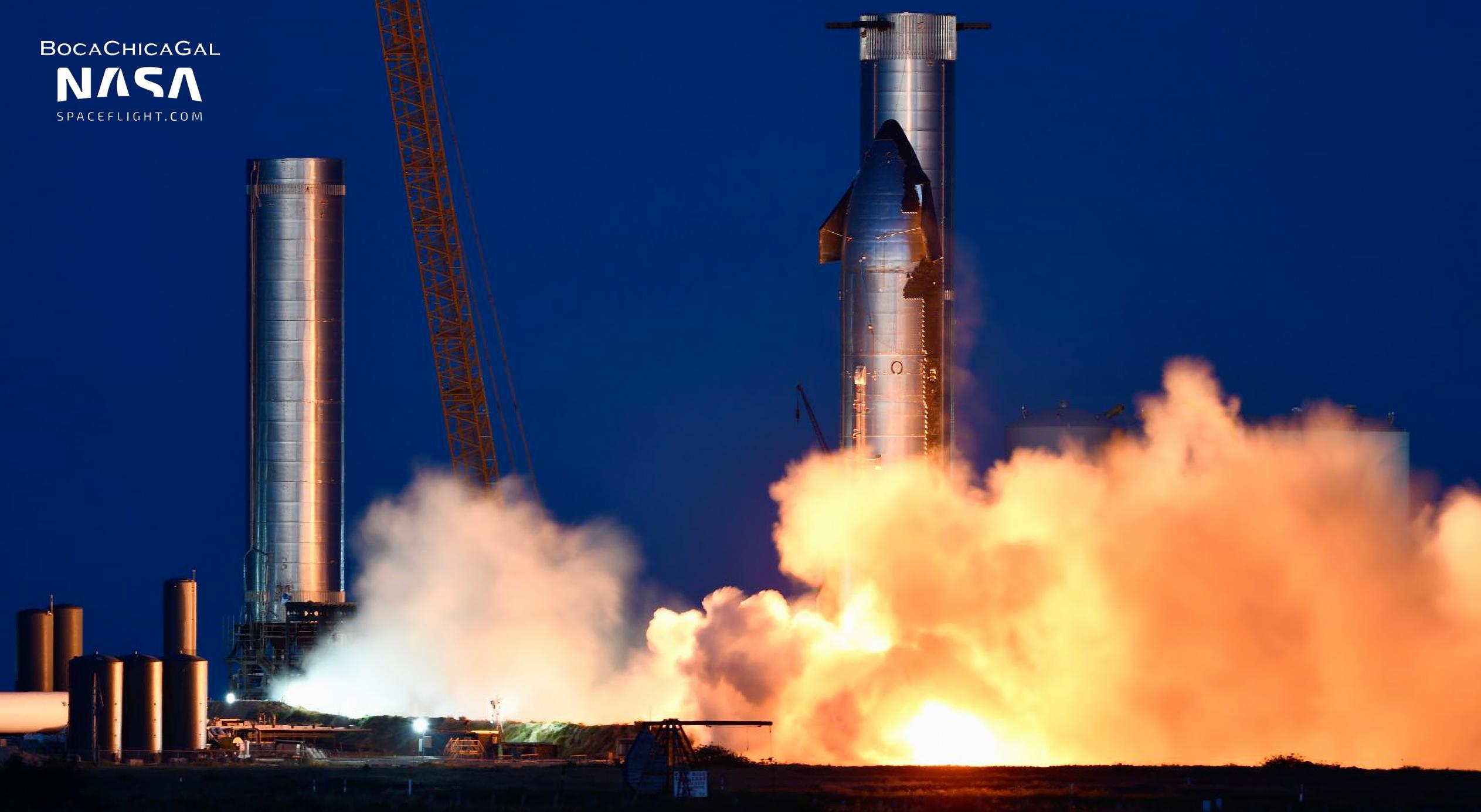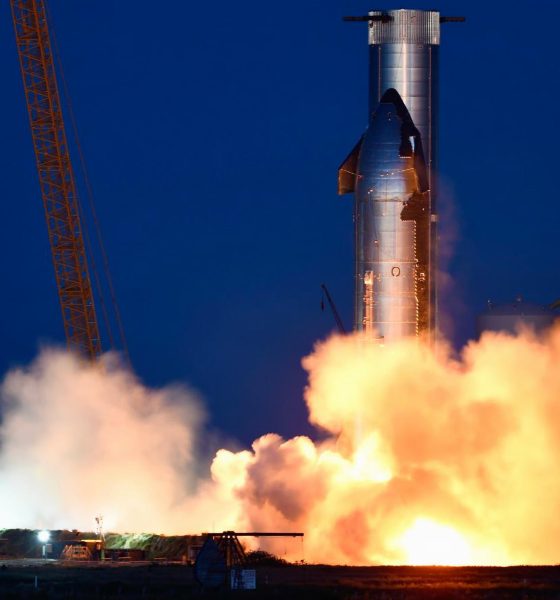

News
SpaceX Starship fires up Raptor Vacuum engine twice in one hour
After weeks of exceptionally cautious buildup, SpaceX’s first orbital-class Starship prototype has repeatedly broken new ground tests in the first few hours of its first static fire test window.
SpaceX first installed Starship S20 on one of two suborbital launch and test stands more than two months ago. After almost six weeks of largely invisible work, longer than any other new Starship prototype has spent inactive at Starbase launch facilities, Ship 20 came to life for the first time during a ‘pneumatic proof’ test completed on September 27th. Two days later, put the Starship through a complex cryogenic proof test, loading supercool liquid nitrogen instead of ambient-temperature gas and simulating the thrust of six Raptor engines with hydraulic rams.
According to CEO Elon Musk, Ship 20 passed its first ‘cryoproof’ without issue, opening the door for static fire testing with real methane and oxygen (LCH4/LOx) propellant and Raptor engines. However, for unknown reasons, it would ultimately take SpaceX more than three weeks of additional work to prepare Starship S20 for its first engine-involved test.
On October 19th, near the end of a seven-hour test window, Starship S20 sort of fired up for the first time, completing what is known as a preburner test. Effectively the first half of static fire test without full ignition, it was nevertheless the first time a Raptor Vacuum engine was operated on a Starship prototype. Originally, based on road closures scheduled with Cameron County, Texas, that preburner test and associated static fire testing was initially scheduled to begin as early as Friday, September 31st.
SpaceX continued to file for and cancel closures throughout the next week, culminating in a few local residents receiving a routine safety notice about a possible test on October 13th. That attempt was canceled soon after and SpaceX ultimately distributed alerts for tests on October 14th and October 18th. Ship 20’s first preburner test was completed on the 19th, followed by another soon-to-be-rescinded notice on the 20th.
Finally, after perhaps the windiest road yet for a Starship from cryoproof to static fire, Starship S20 sailed through a static fire test flow on October 21st and ultimately fired up for the first time ever at 7:16 pm CDT (00:16 UTC). In perfect opposition to weeks of unprecedentedly slow testing, Starship S20 not only completed its first true static fire early in the test window, but it completed the first on-vehicle static fire of a Raptor Vacuum engine and then, just over an hour later, performed a second static fire – this time simultaneously igniting both a Raptor Vacuum and Raptor Center (sea-level-optimized) engine. Aside from also marking the first time that two Raptor variants have been simultaneously fired on the same vehicle, Starship S20’s two-test surprise was technically the fastest back-to-back static fire SpaceX has ever completed, beating Starship SN9 by about 15 minutes.
Back in January 2021, SN9 completed an unprecedented three back-to-back-to-back Raptor static fires in less than 100 minutes as part of what Musk described as “[a day] about practicing Starship engine starts.” SN9 ultimately completed two of those tests in 75 minutes, setting a niche but still impressive turnaround record. Starship S20, however, managed two static fires in 62 minutes on October 21st.
With any luck, Ship 20’s unexpected first-test milestones will mark the start of a more energetic period for the orbital-class prototype, potentially building up to the first Starship static fire with more than three Raptors and the first test with all six engines installed. Super Heavy Booster 4 is also well overdue for its own proof and static fire test campaign, virtually all of which will be new territory for SpaceX.

Elon Musk
Starlink passes 9 million active customers just weeks after hitting 8 million
The milestone highlights the accelerating growth of Starlink, which has now been adding over 20,000 new users per day.

SpaceX’s Starlink satellite internet service has continued its rapid global expansion, surpassing 9 million active customers just weeks after crossing the 8 million mark.
The milestone highlights the accelerating growth of Starlink, which has now been adding over 20,000 new users per day.
9 million customers
In a post on X, SpaceX stated that Starlink now serves over 9 million active users across 155 countries, territories, and markets. The company reached 8 million customers in early November, meaning it added roughly 1 million subscribers in under seven weeks, or about 21,275 new users on average per day.
“Starlink is connecting more than 9M active customers with high-speed internet across 155 countries, territories, and many other markets,” Starlink wrote in a post on its official X account. SpaceX President Gwynne Shotwell also celebrated the milestone on X. “A huge thank you to all of our customers and congrats to the Starlink team for such an incredible product,” she wrote.
That growth rate reflects both rising demand for broadband in underserved regions and Starlink’s expanding satellite constellation, which now includes more than 9,000 low-Earth-orbit satellites designed to deliver high-speed, low-latency internet worldwide.
Starlink’s momentum
Starlink’s momentum has been building up. SpaceX reported 4.6 million Starlink customers in December 2024, followed by 7 million by August 2025, and 8 million customers in November. Independent data also suggests Starlink usage is rising sharply, with Cloudflare reporting that global web traffic from Starlink users more than doubled in 2025, as noted in an Insider report.
Starlink’s momentum is increasingly tied to SpaceX’s broader financial outlook. Elon Musk has said the satellite network is “by far” the company’s largest revenue driver, and reports suggest SpaceX may be positioning itself for an initial public offering as soon as next year, with valuations estimated as high as $1.5 trillion. Musk has also suggested in the past that Starlink could have its own IPO in the future.
News
NVIDIA Director of Robotics: Tesla FSD v14 is the first AI to pass the “Physical Turing Test”
After testing FSD v14, Fan stated that his experience with FSD felt magical at first, but it soon started to feel like a routine.

NVIDIA Director of Robotics Jim Fan has praised Tesla’s Full Self-Driving (Supervised) v14 as the first AI to pass what he described as a “Physical Turing Test.”
After testing FSD v14, Fan stated that his experience with FSD felt magical at first, but it soon started to feel like a routine. And just like smartphones today, removing it now would “actively hurt.”
Jim Fan’s hands-on FSD v14 impressions
Fan, a leading researcher in embodied AI who is currently solving Physical AI at NVIDIA and spearheading the company’s Project GR00T initiative, noted that he actually was late to the Tesla game. He was, however, one of the first to try out FSD v14.
“I was very late to own a Tesla but among the earliest to try out FSD v14. It’s perhaps the first time I experience an AI that passes the Physical Turing Test: after a long day at work, you press a button, lay back, and couldn’t tell if a neural net or a human drove you home,” Fan wrote in a post on X.
Fan added: “Despite knowing exactly how robot learning works, I still find it magical watching the steering wheel turn by itself. First it feels surreal, next it becomes routine. Then, like the smartphone, taking it away actively hurts. This is how humanity gets rewired and glued to god-like technologies.”
The Physical Turing Test
The original Turing Test was conceived by Alan Turing in 1950, and it was aimed at determining if a machine could exhibit behavior that is equivalent to or indistinguishable from a human. By focusing on text-based conversations, the original Turing Test set a high bar for natural language processing and machine learning.
This test has been passed by today’s large language models. However, the capability to converse in a humanlike manner is a completely different challenge from performing real-world problem-solving or physical interactions. Thus, Fan introduced the Physical Turing Test, which challenges AI systems to demonstrate intelligence through physical actions.
Based on Fan’s comments, Tesla has demonstrated these intelligent physical actions with FSD v14. Elon Musk agreed with the NVIDIA executive, stating in a post on X that with FSD v14, “you can sense the sentience maturing.” Musk also praised Tesla AI, calling it the best “real-world AI” today.
News
Tesla AI team burns the Christmas midnight oil by releasing FSD v14.2.2.1
The update was released just a day after FSD v14.2.2 started rolling out to customers.

Tesla is burning the midnight oil this Christmas, with the Tesla AI team quietly rolling out Full Self-Driving (Supervised) v14.2.2.1 just a day after FSD v14.2.2 started rolling out to customers.
Tesla owner shares insights on FSD v14.2.2.1
Longtime Tesla owner and FSD tester @BLKMDL3 shared some insights following several drives with FSD v14.2.2.1 in rainy Los Angeles conditions with standing water and faded lane lines. He reported zero steering hesitation or stutter, confident lane changes, and maneuvers executed with precision that evoked the performance of Tesla’s driverless Robotaxis in Austin.
Parking performance impressed, with most spots nailed perfectly, including tight, sharp turns, in single attempts without shaky steering. One minor offset happened only due to another vehicle that was parked over the line, which FSD accommodated by a few extra inches. In rain that typically erases road markings, FSD visualized lanes and turn lines better than humans, positioning itself flawlessly when entering new streets as well.
“Took it up a dark, wet, and twisty canyon road up and down the hill tonight and it went very well as to be expected. Stayed centered in the lane, kept speed well and gives a confidence inspiring steering feel where it handles these curvy roads better than the majority of human drivers,” the Tesla owner wrote in a post on X.
Tesla’s FSD v14.2.2 update
Just a day before FSD v14.2.2.1’s release, Tesla rolled out FSD v14.2.2, which was focused on smoother real-world performance, better obstacle awareness, and precise end-of-trip routing. According to the update’s release notes, FSD v14.2.2 upgrades the vision encoder neural network with higher resolution features, enhancing detection of emergency vehicles, road obstacles, and human gestures.
New Arrival Options also allowed users to select preferred drop-off styles, such as Parking Lot, Street, Driveway, Parking Garage, or Curbside, with the navigation pin automatically adjusting to the ideal spot. Other refinements include pulling over for emergency vehicles, real-time vision-based detours for blocked roads, improved gate and debris handling, and Speed Profiles for customized driving styles.








